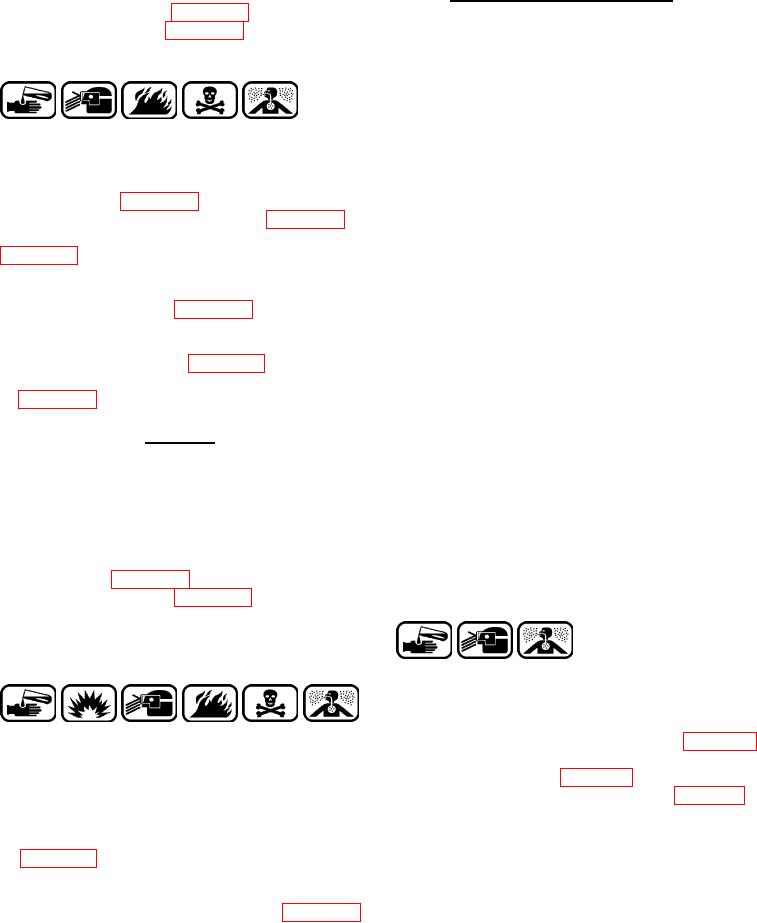
01 March 2005
NAVAIR 01-1A-509-3
TM 1-1500-344-23-3
TO 1-1-689-3
b. Remove corrosion and tarnish with Typewriter
6-3.17. STATIC WICK DISCHARGERS. Corrosion,
Eraser, (Volume IV or V, Chapter 2), or Eraser, Ruby
deterioration, and/or damage of the static wick
Red, (Volume IV or V, Chapter 2). Care should be
dischargers can result in poor performance of the
taken not to remove thin plating from the surfaces.
aircraft's radios and communications systems, erratic
operation of instruments, and potential electrical shock
to personnel. When found to be damaged or corroded,
the static wick dischargers should be replaced as
follows:
Alcohol, Isopropyl
6
TT-I-735
NOTE
c. Clean residue with Isopropyl Alcohol, TT-I-735
(Navy) Av-DEC gasket installation requires
(Volume IV or V, Chapter 2). Apply with Acid Brush,
authorization from the cognizant type/model/
A-A-289 style optional (Volume IV or V, Chapter 3), or
series engineering authority for the aircraft.
Brush Typewriter, A-A-3077 Style T (Volume IV or V,
These procedures are applicable to all static
dischargers except in accordance with aircraft
d. Remove residue with Cleaning Cloth, CCC-C-46
specific technical manuals. The mounting
Class 7 (Volume IV or V, Chapter 2).
bases of static dischargers can vary in shape
and size. The following installation procedures
e. Rinse affected area with Isopropyl Alcohol,
are typical and should be used on all static
TT-I-735 (Volume IV or V, Chapter 2), and wipe dry
dischargers allowing the use of a gasket.
with Cleaning Cloth, CCC-C-46 Class 7, (Volume IV or
V, Chapter 2). This step will assist in removing water.
a. Remove and discard old static discharger wick
and mounting base plate. Utilization of the radial
CAUTION
bristle disc generates dust particles that may contain
chromates from primers. Eye and respiratory protection
Exercise care when using Hot Air Gun near
is required when operating this tool.
p l a s t i c materials. Excessive heat may
decompose the plastic and/or change its
b. Clean and remove paint and corrosion from the
electrical characteristics.
aircraft surface and static wick discharger mounting
base in accordance with Volume II (Navy and Army) or
f. Air dry or dry with Hot Air Gun, A-A-59435
TO 1-1-691 (Air Force), with radial bristle disc being
(Volume IV or V, Chapter 3), or Hot Air Gun, Raychem,
preferred removal method.
HT-900 (Volume IV or V, Chapter 3), or equivalent.
g. Preservation, where circuit function will not be
affected, shall be as follows:
Compound, Aircraft Cleaning
4
MIL-PRF-85570
c. Thoroughly clean treated area with Cleaning
Compound, Corrosion Preventive
3
Cloth, CCC-C-46 Class 7 (Volume IV or V, Chapter 2)
Water-Displacing
moistened with Cleaning Compound, MIL-PRF-85570
MIL-C-81309
Type II (Volume IV or V, Chapter 2) (Air Force can use
MIL-PRF-87937 Type II or IV (Volume V, Chapter 2)),
(1) Apply a thin film of Water Displacing
using a dilution of nine (9) parts water to one (1) part
Corrosion Preventive Compound, Ultra-Thin Film,
cleaner. Rinse thoroughly until a water break-free
Avionics Grade, MIL-C-81309 Type III (Volume IV or
surface is obtained. Allow to air dry. If water break-free
V, Chapter 2), on all metal surfaces.
surface is not obtained,
(2) Remove excess preservative with Cleaning
Cloth, CCC-C-46 Class 7 (Volume IV or V, Chapter 2).
6-34

